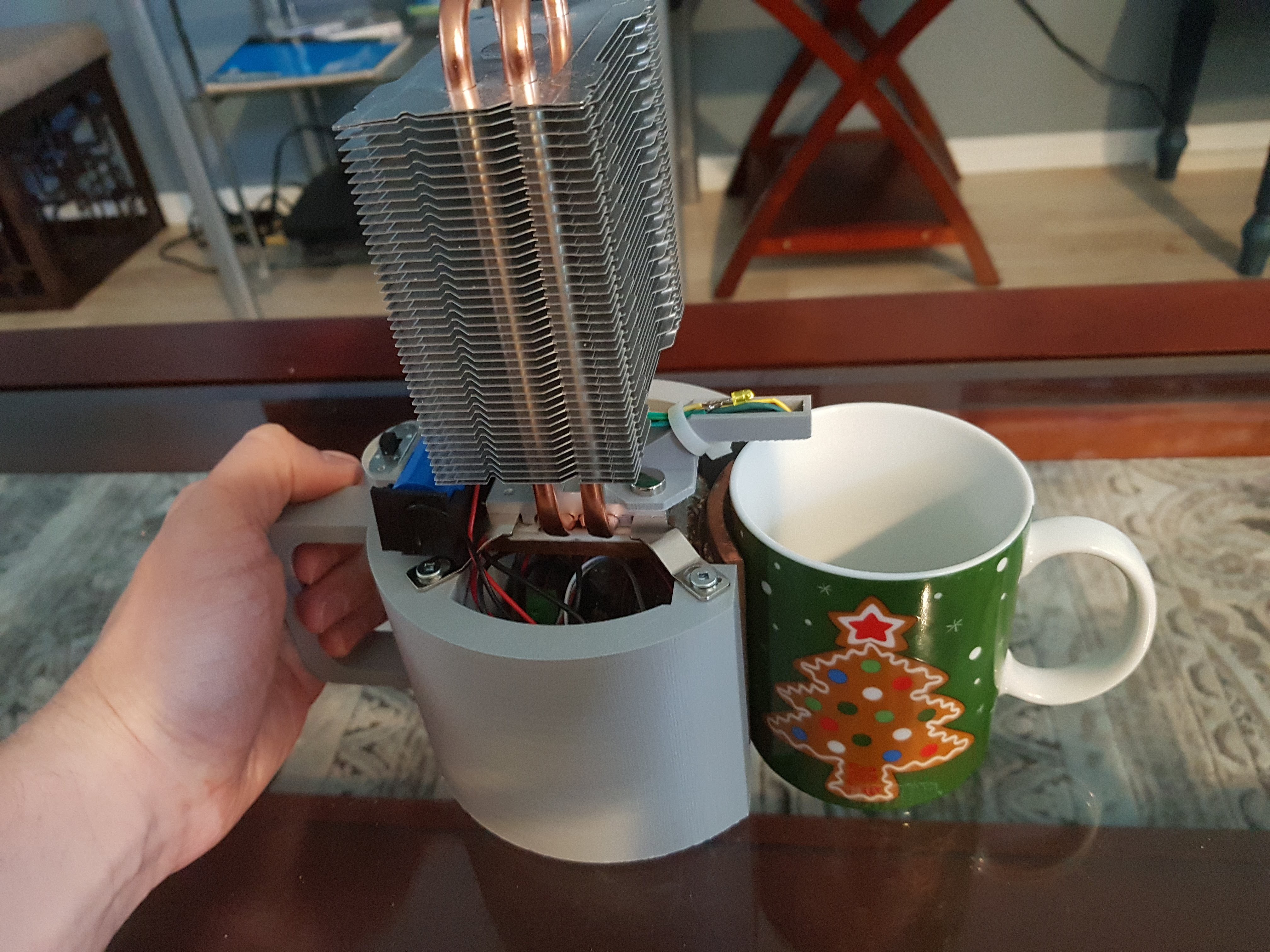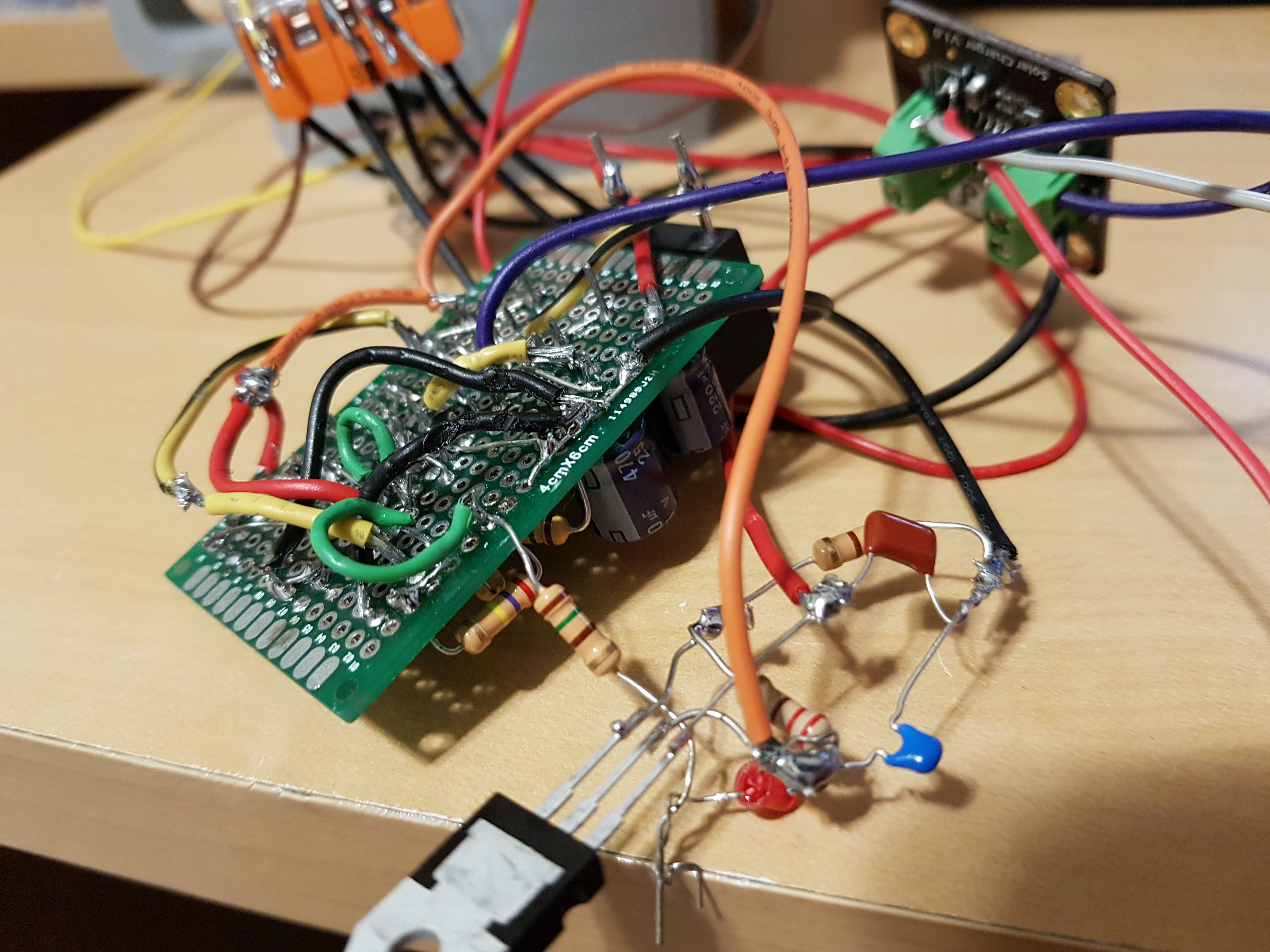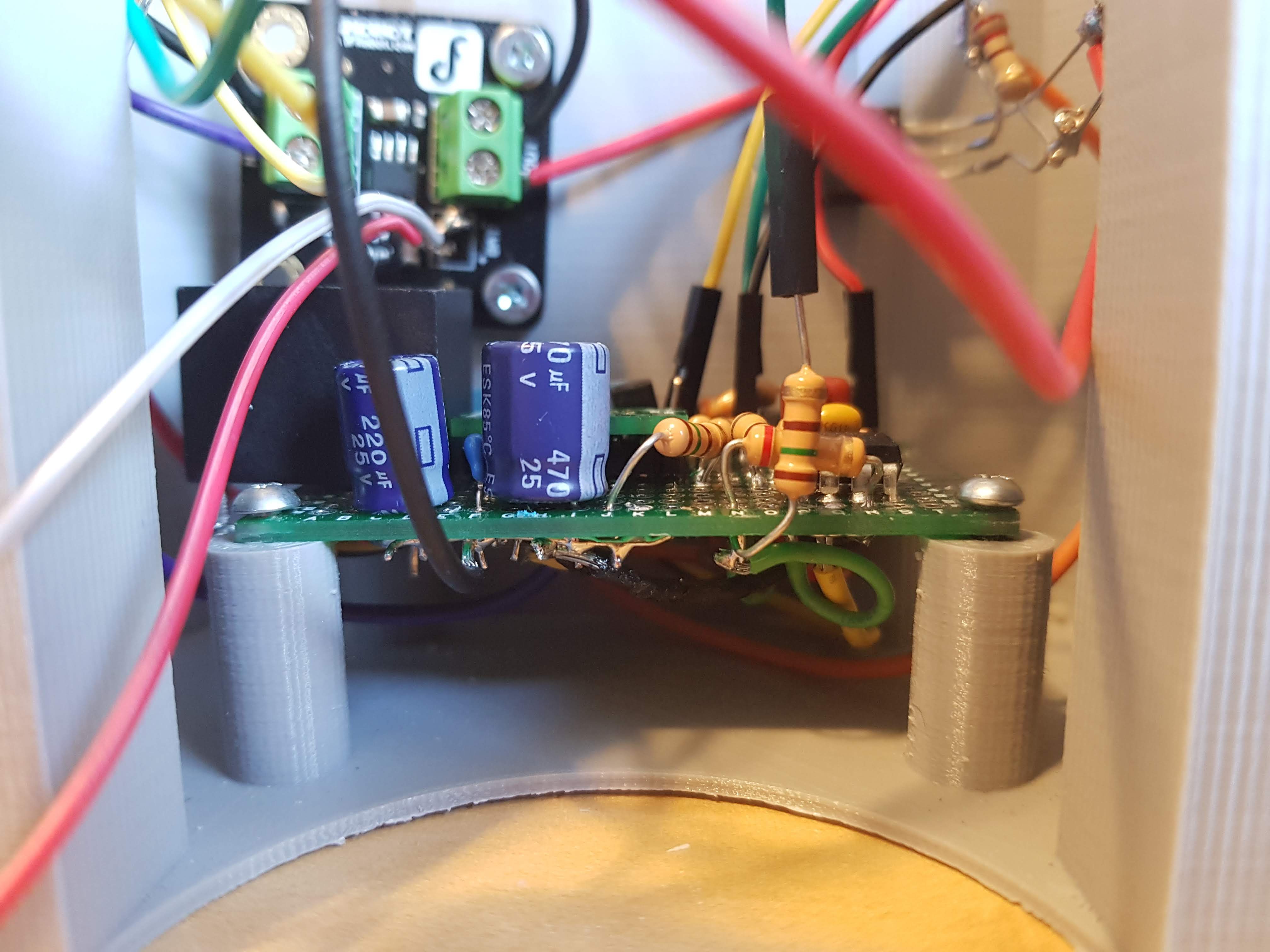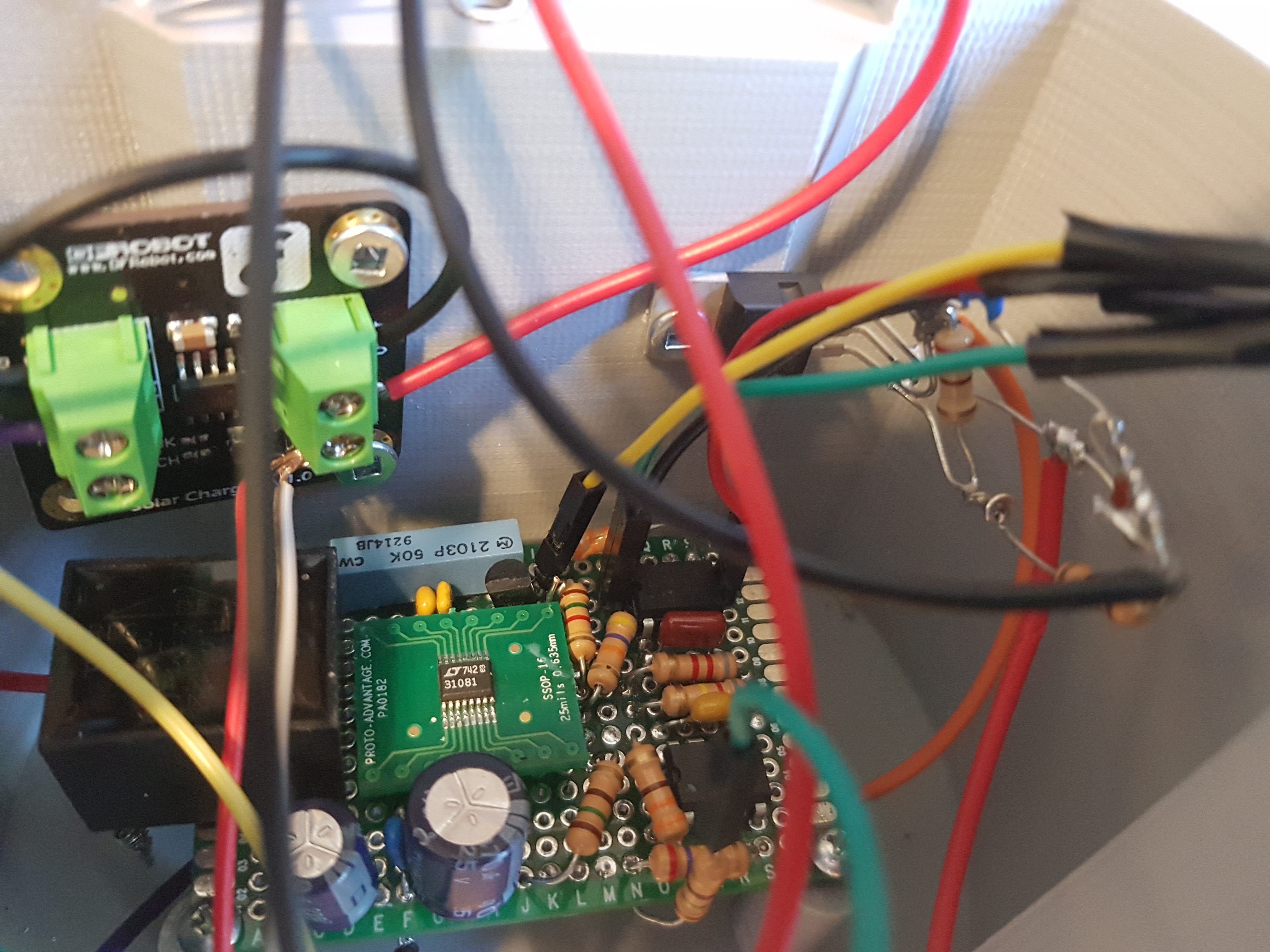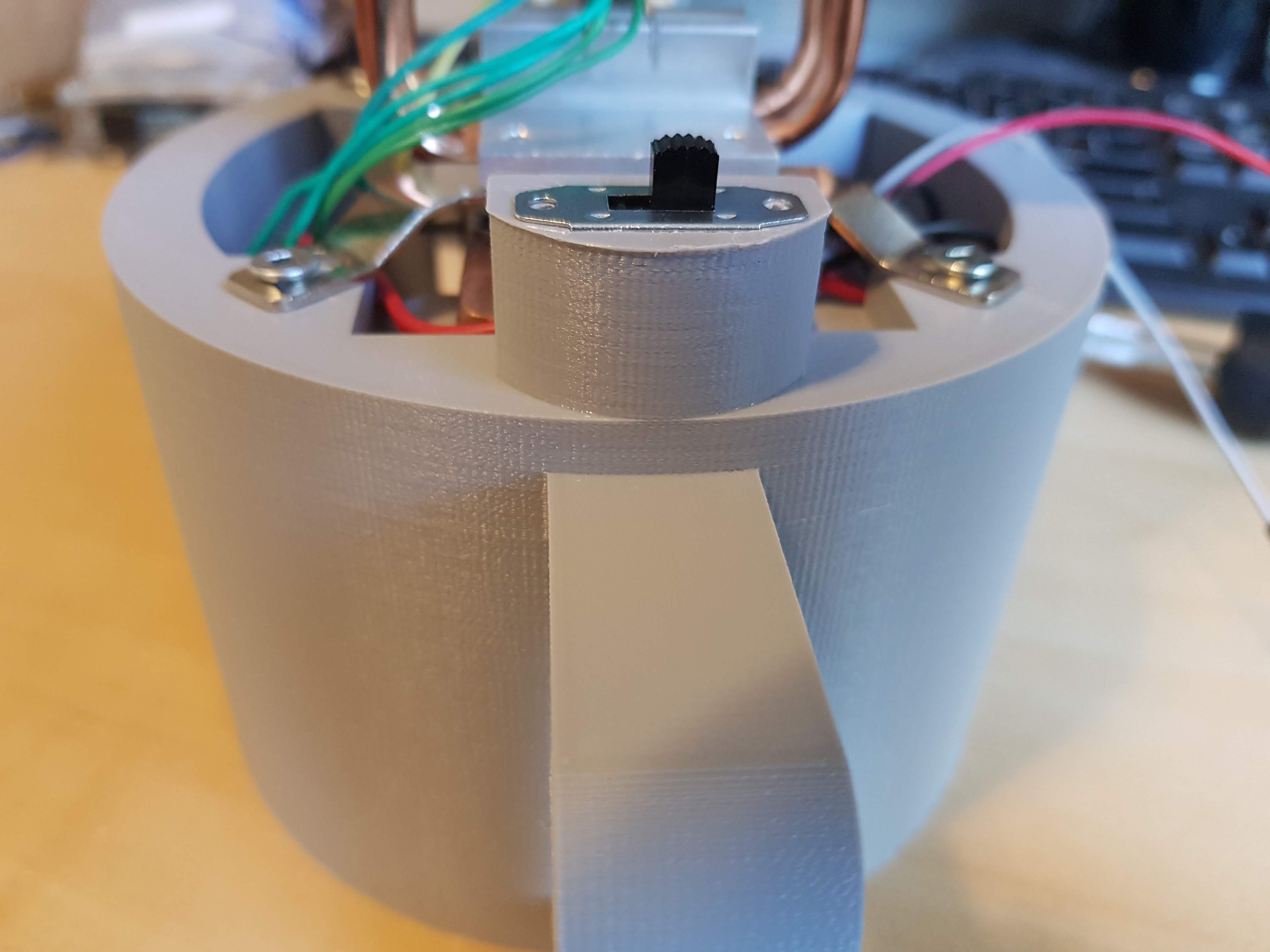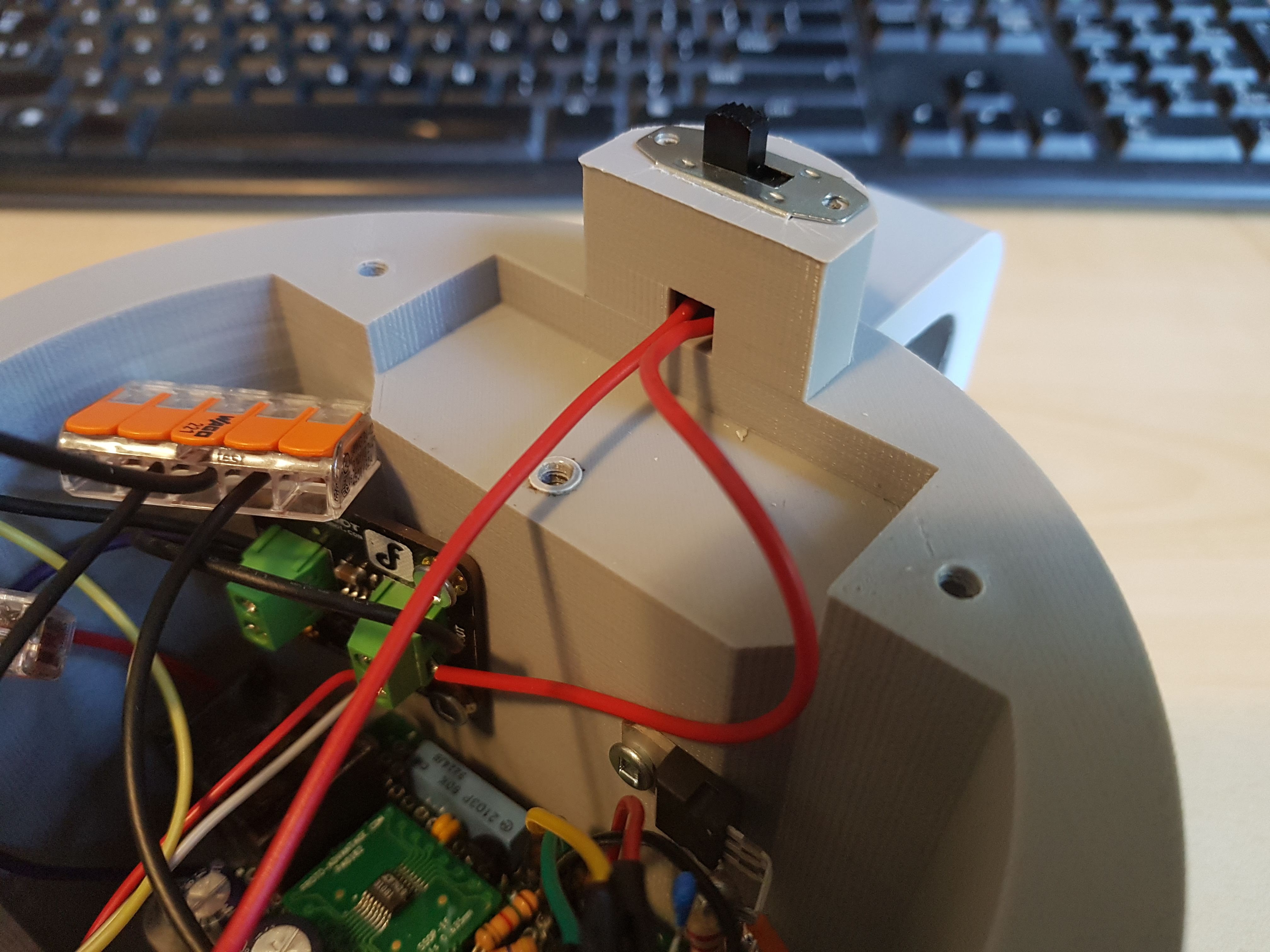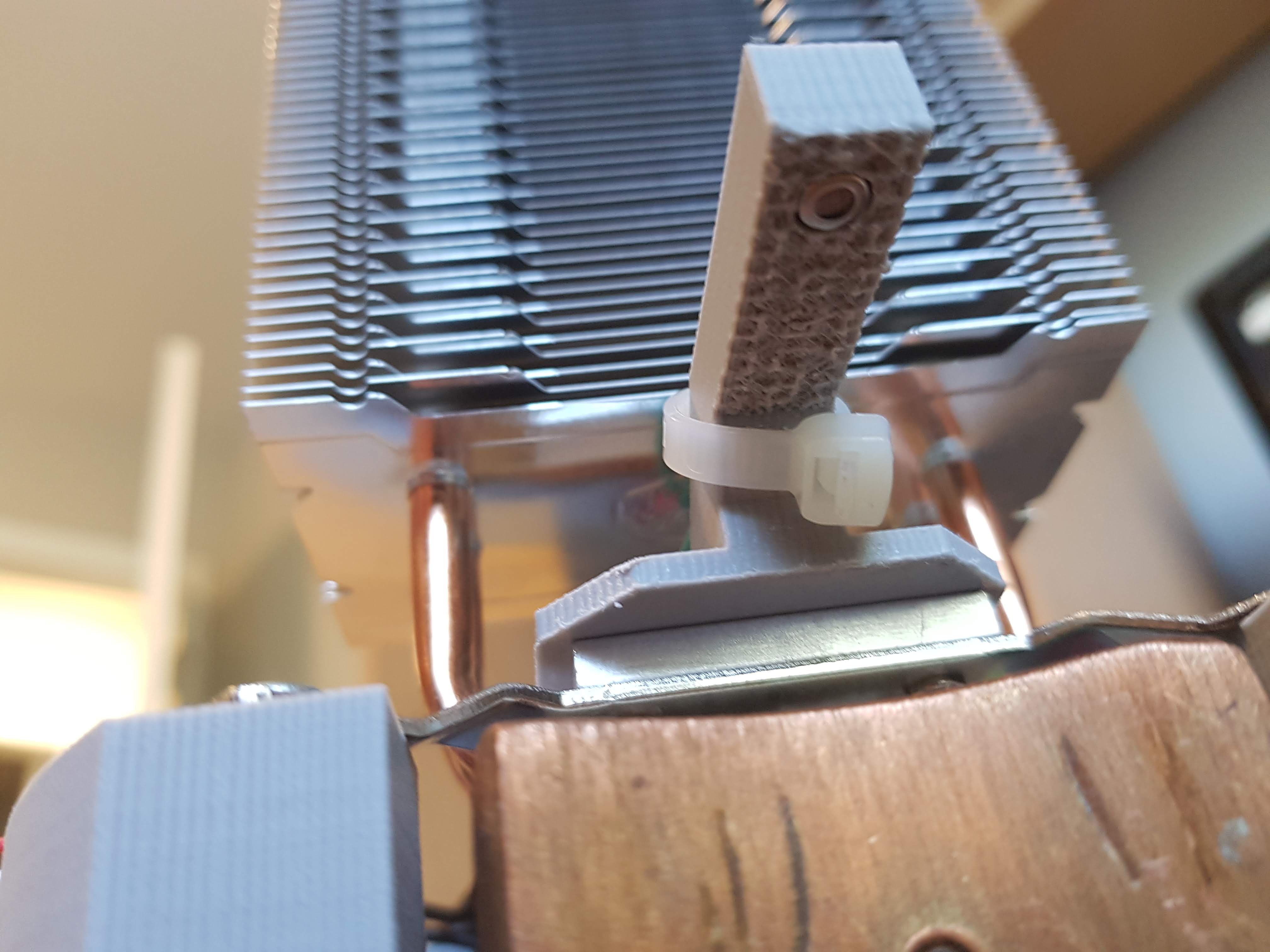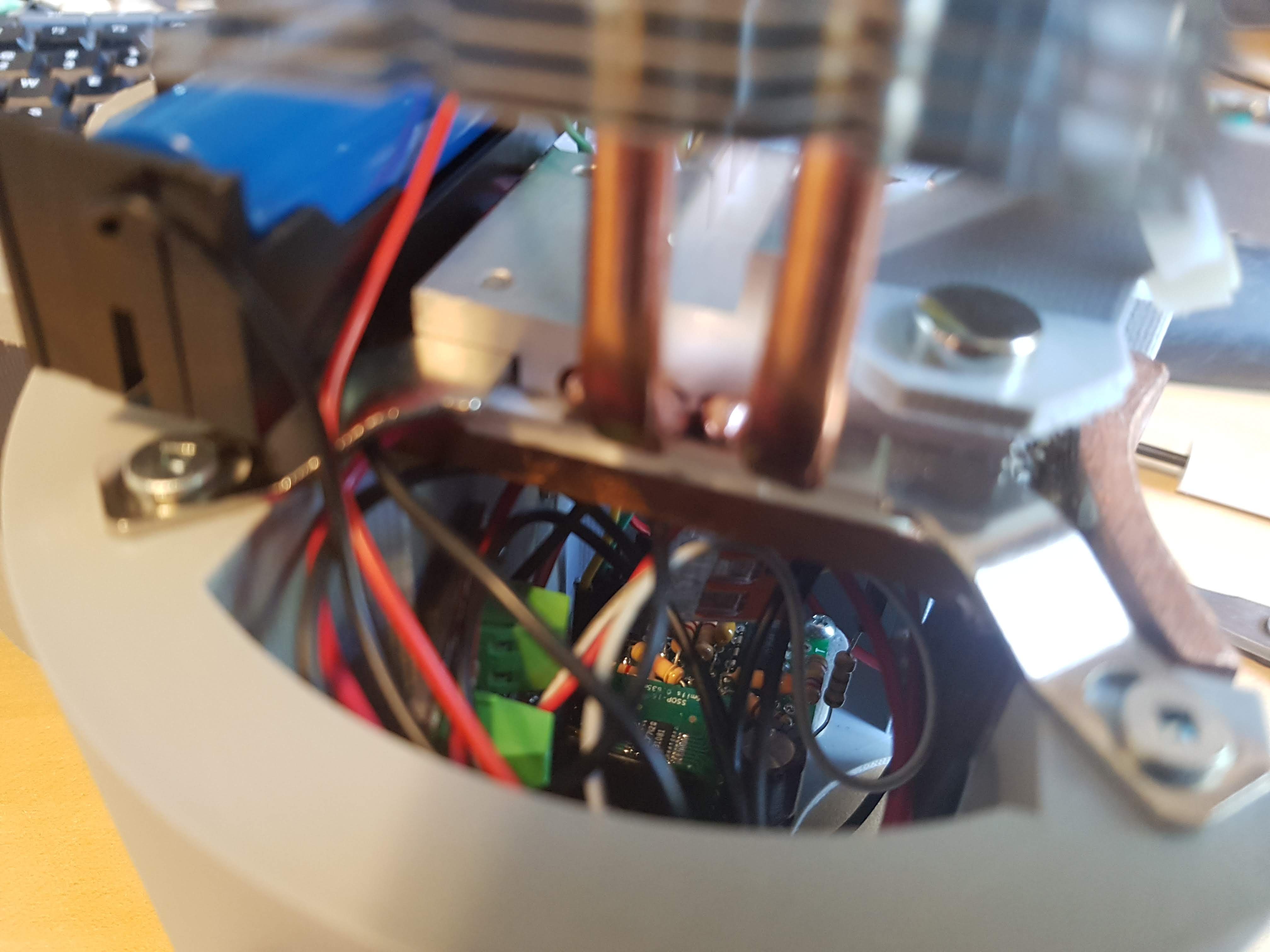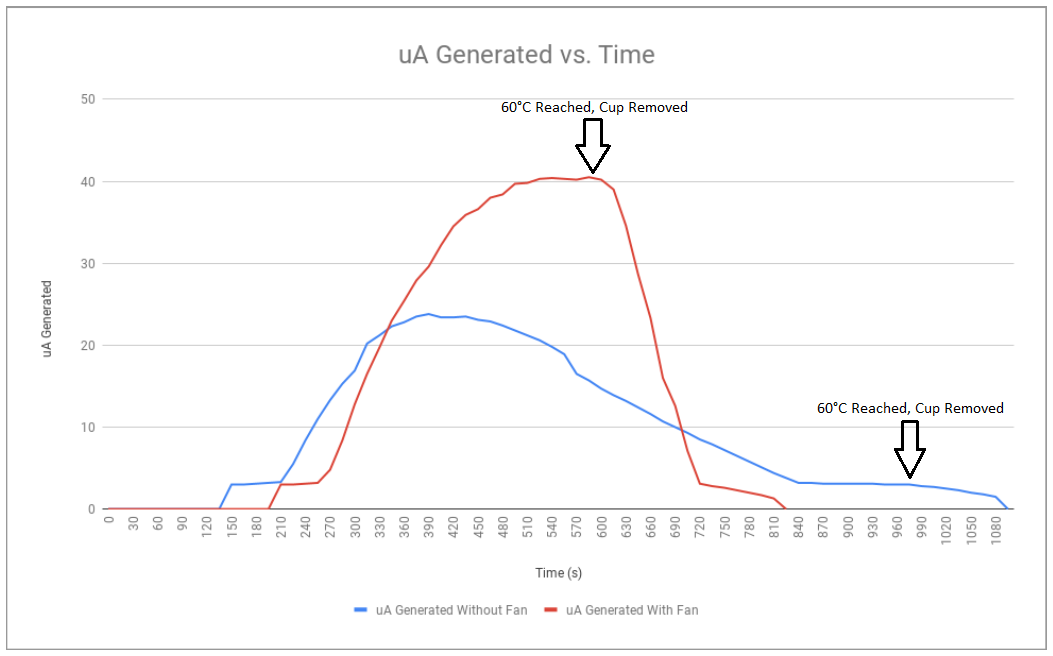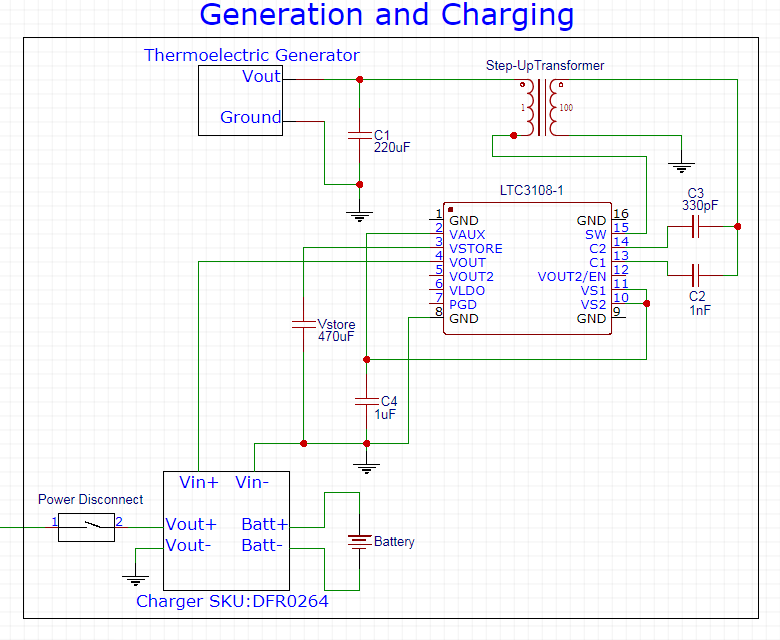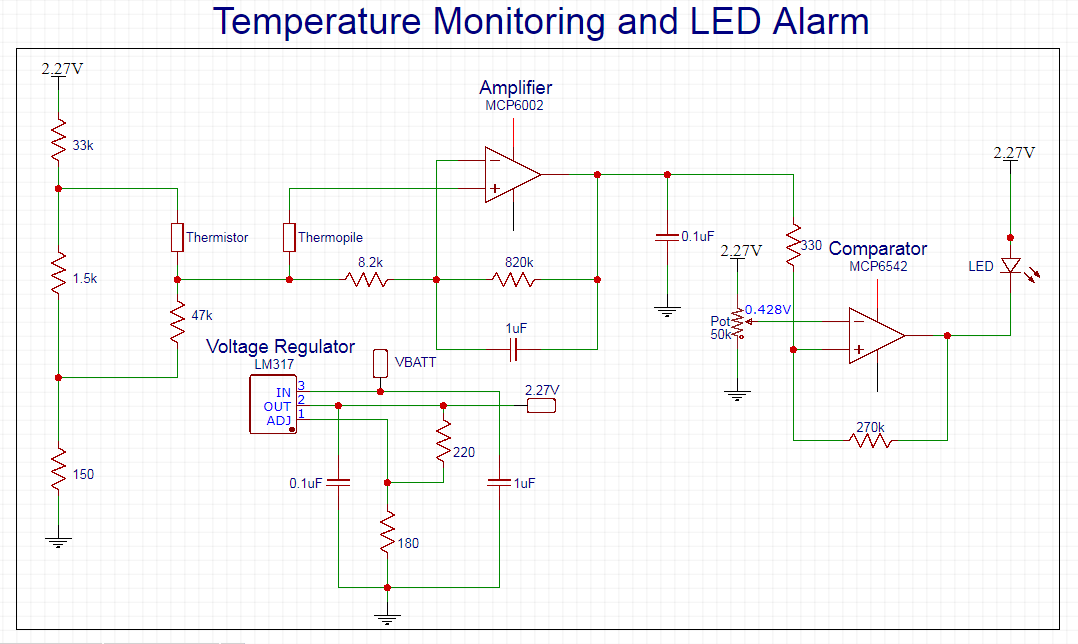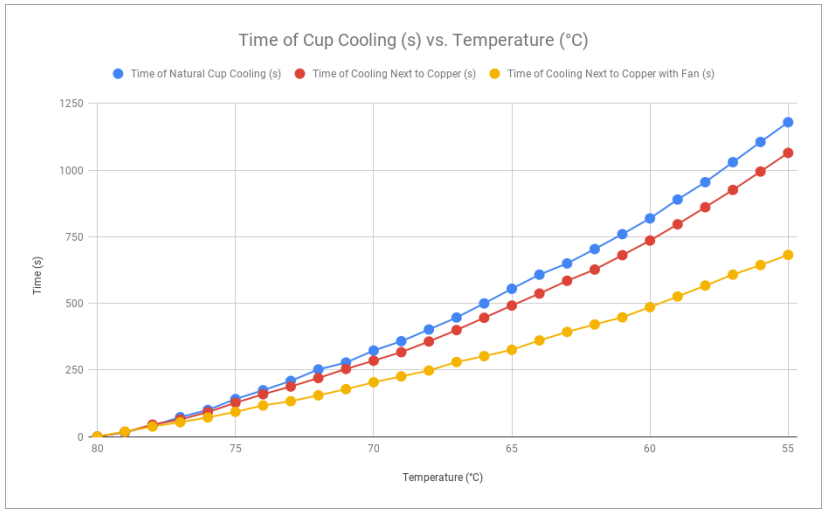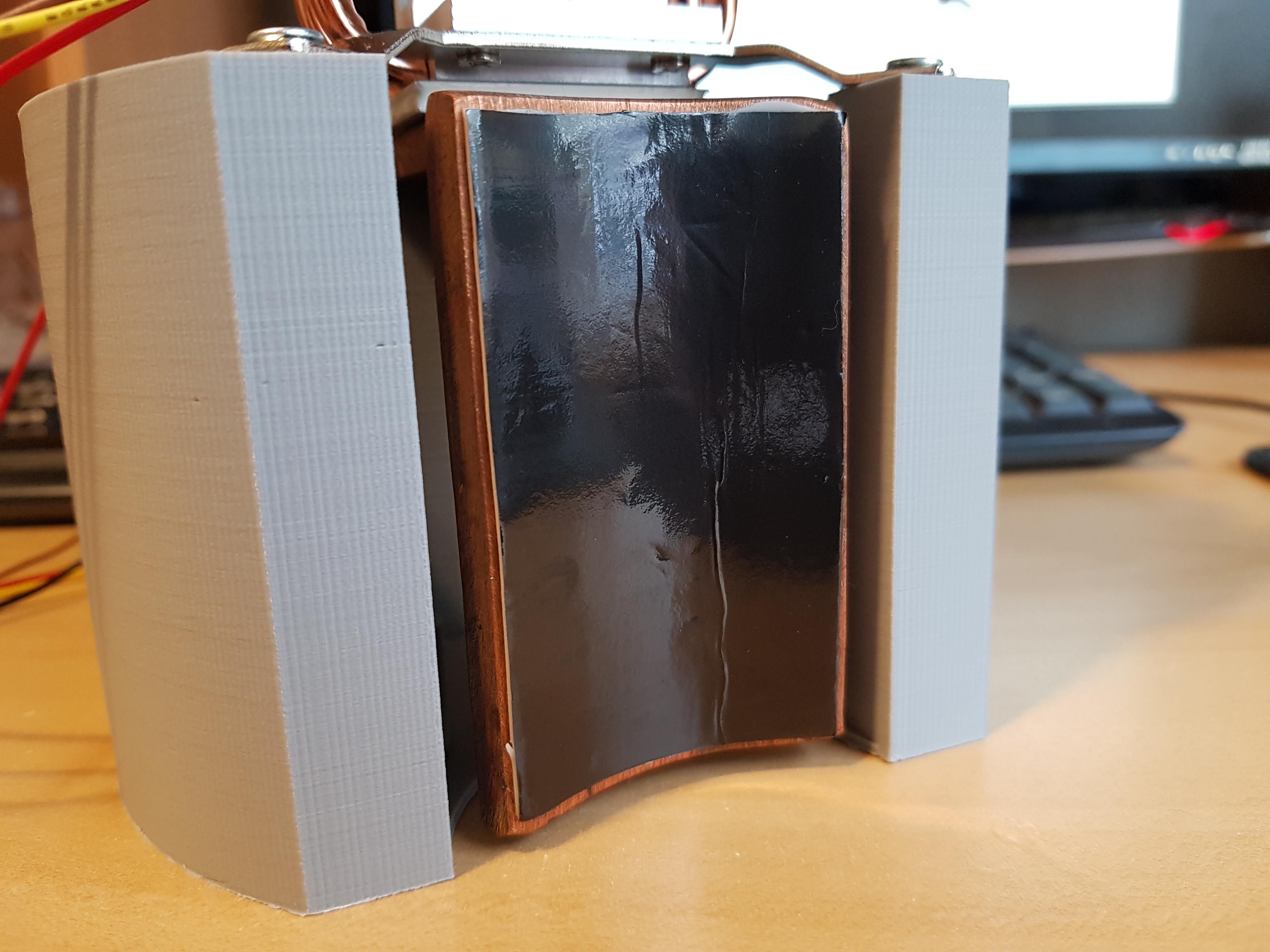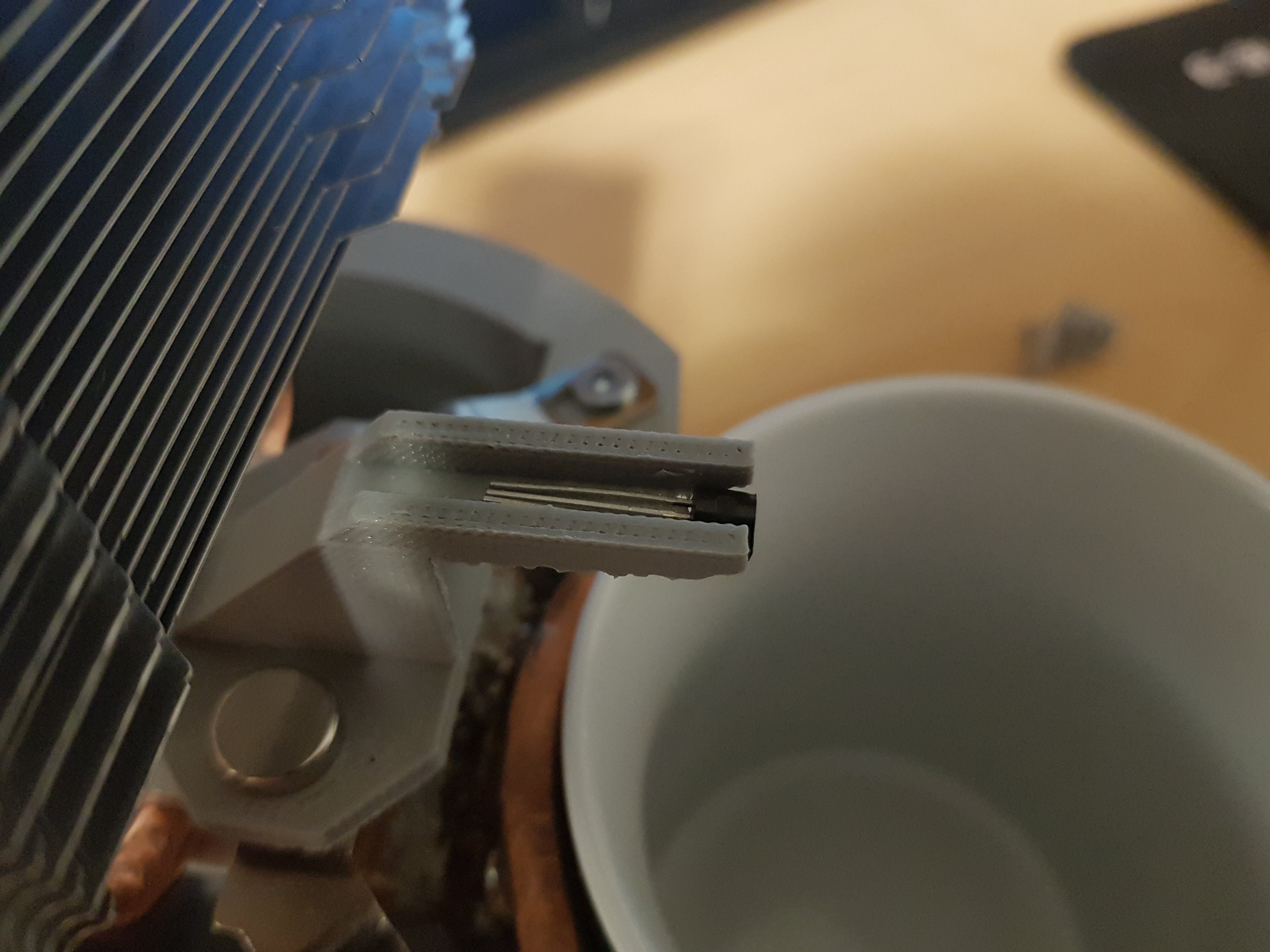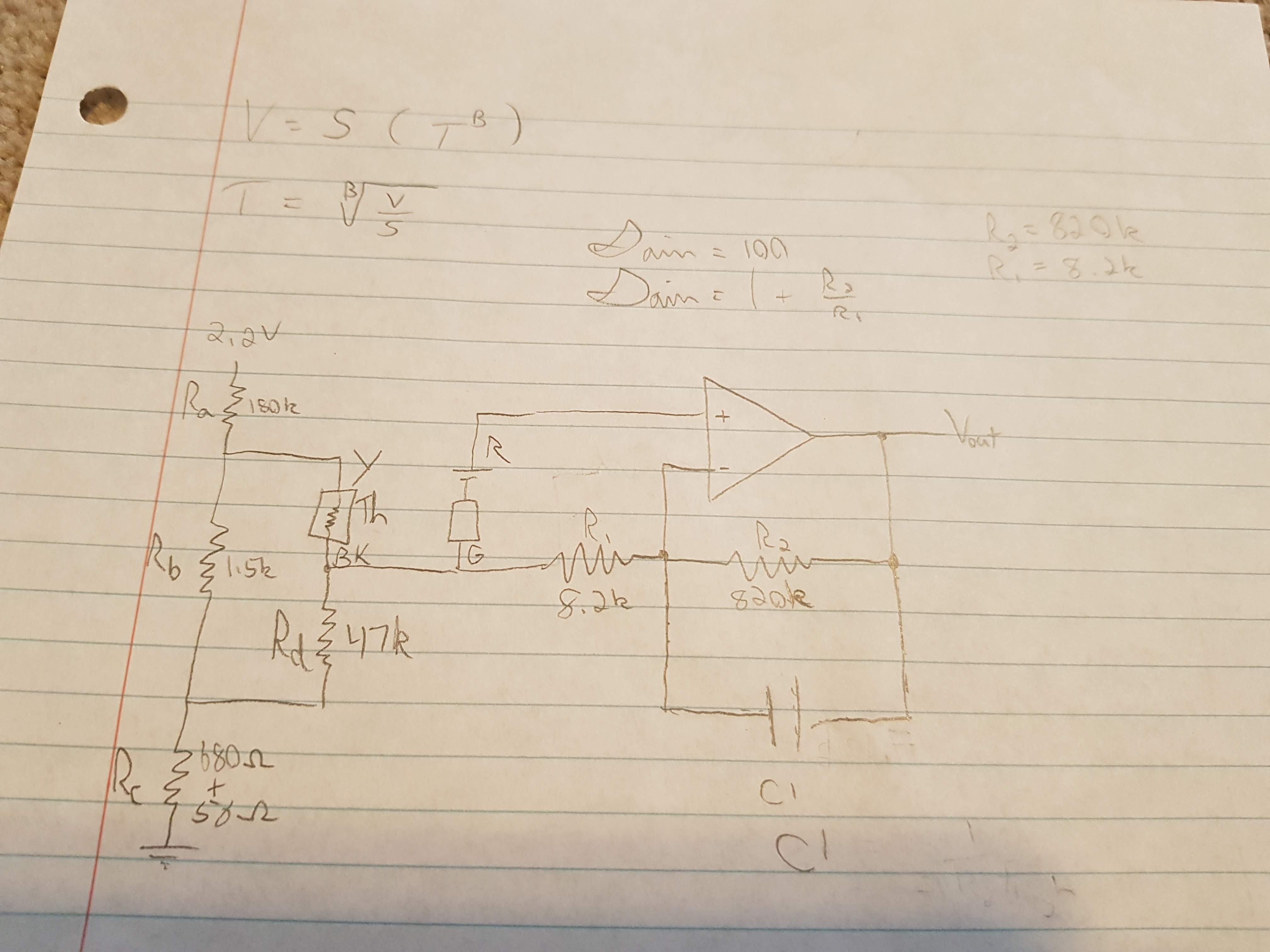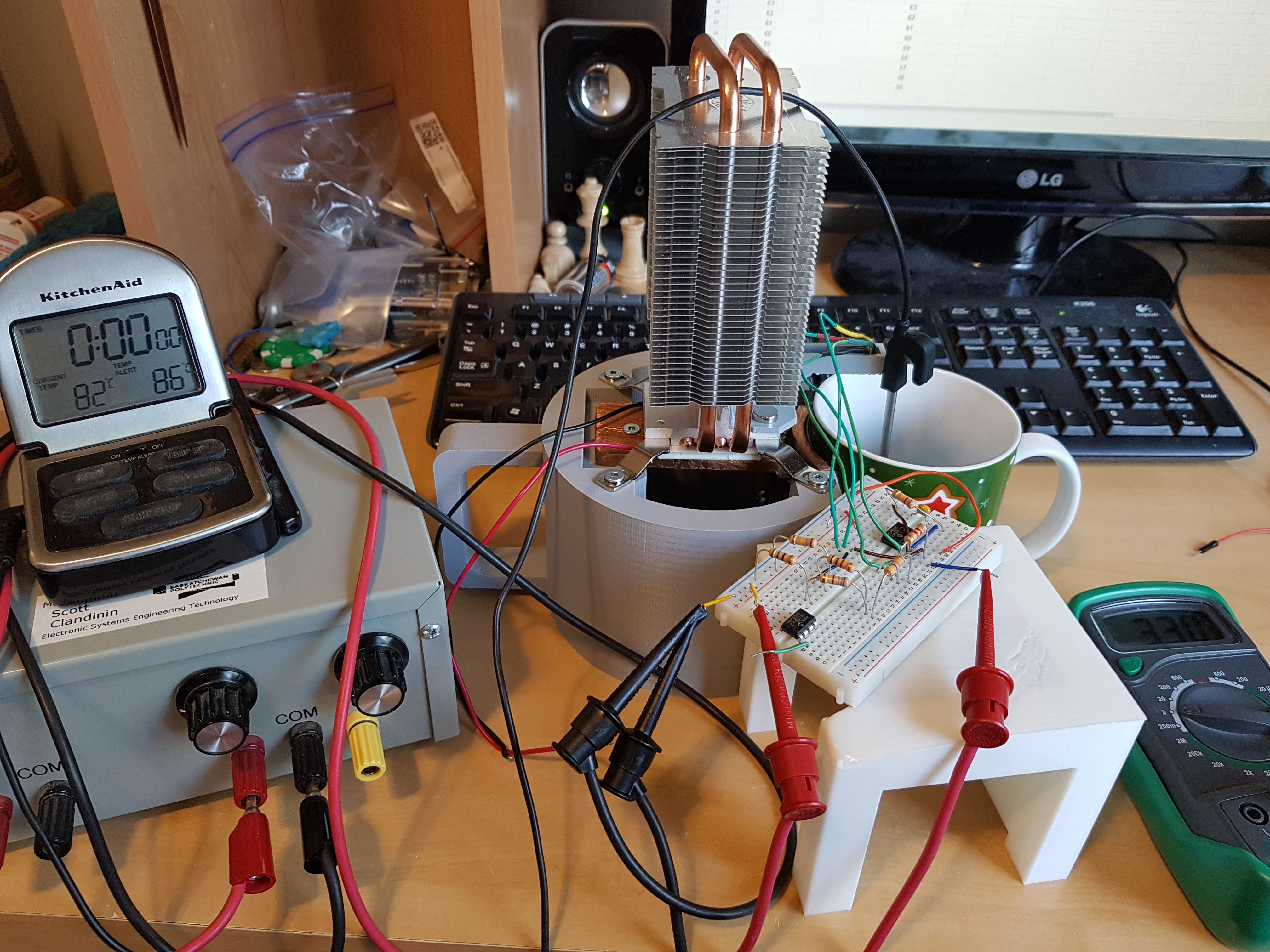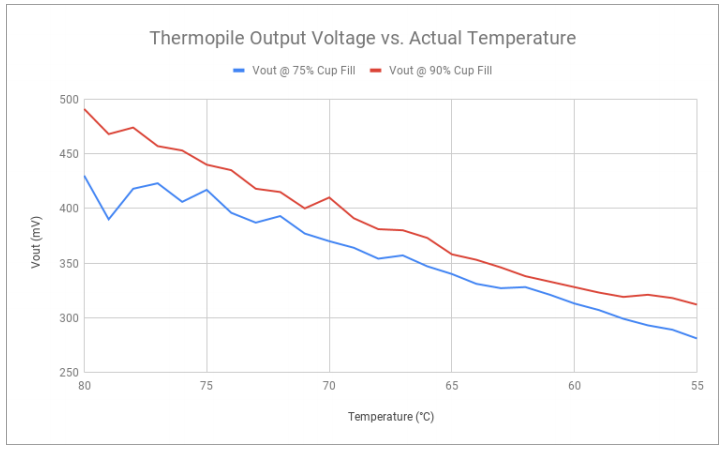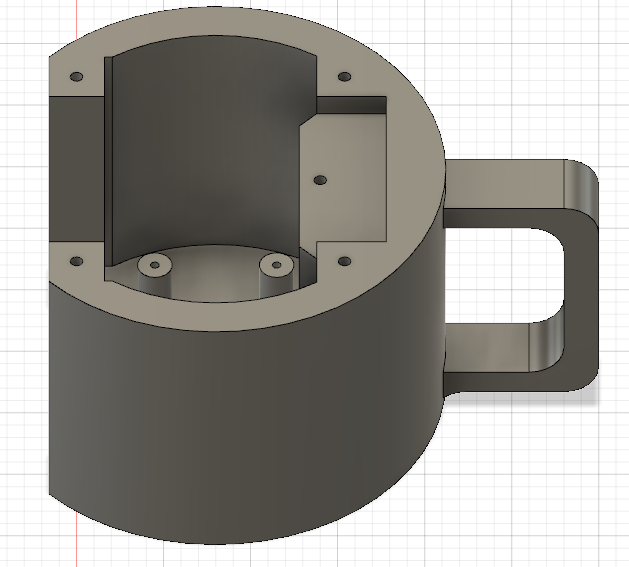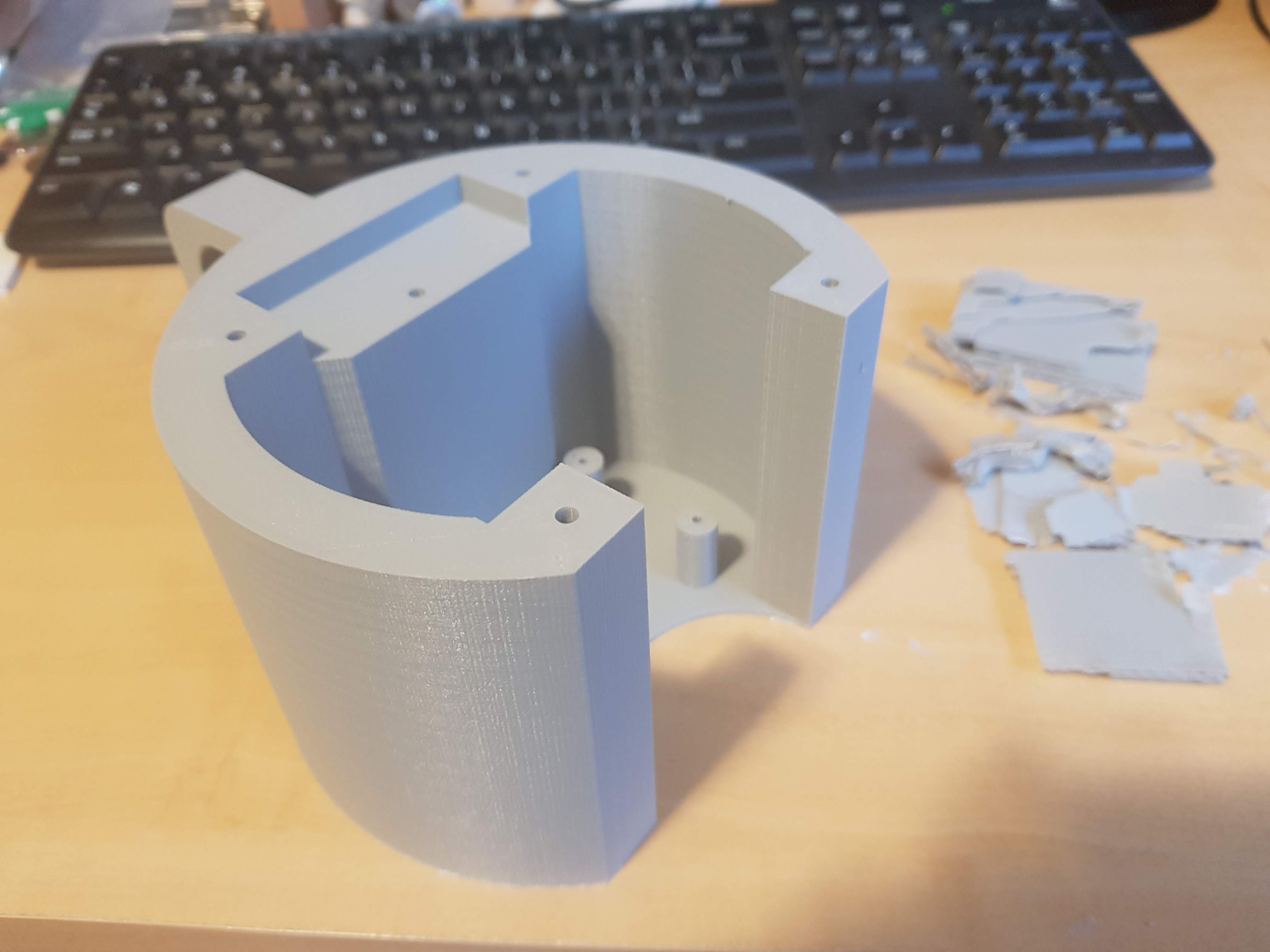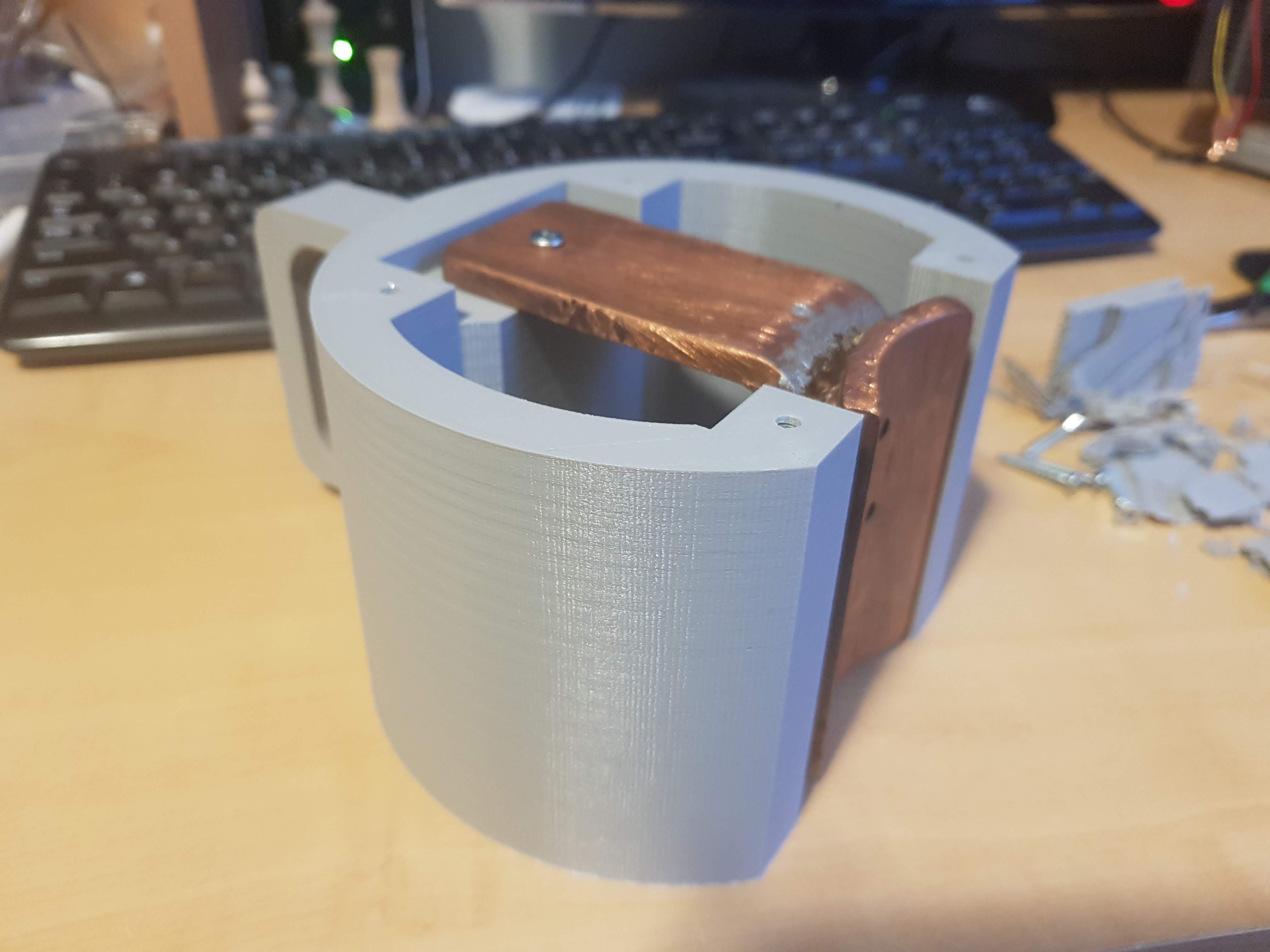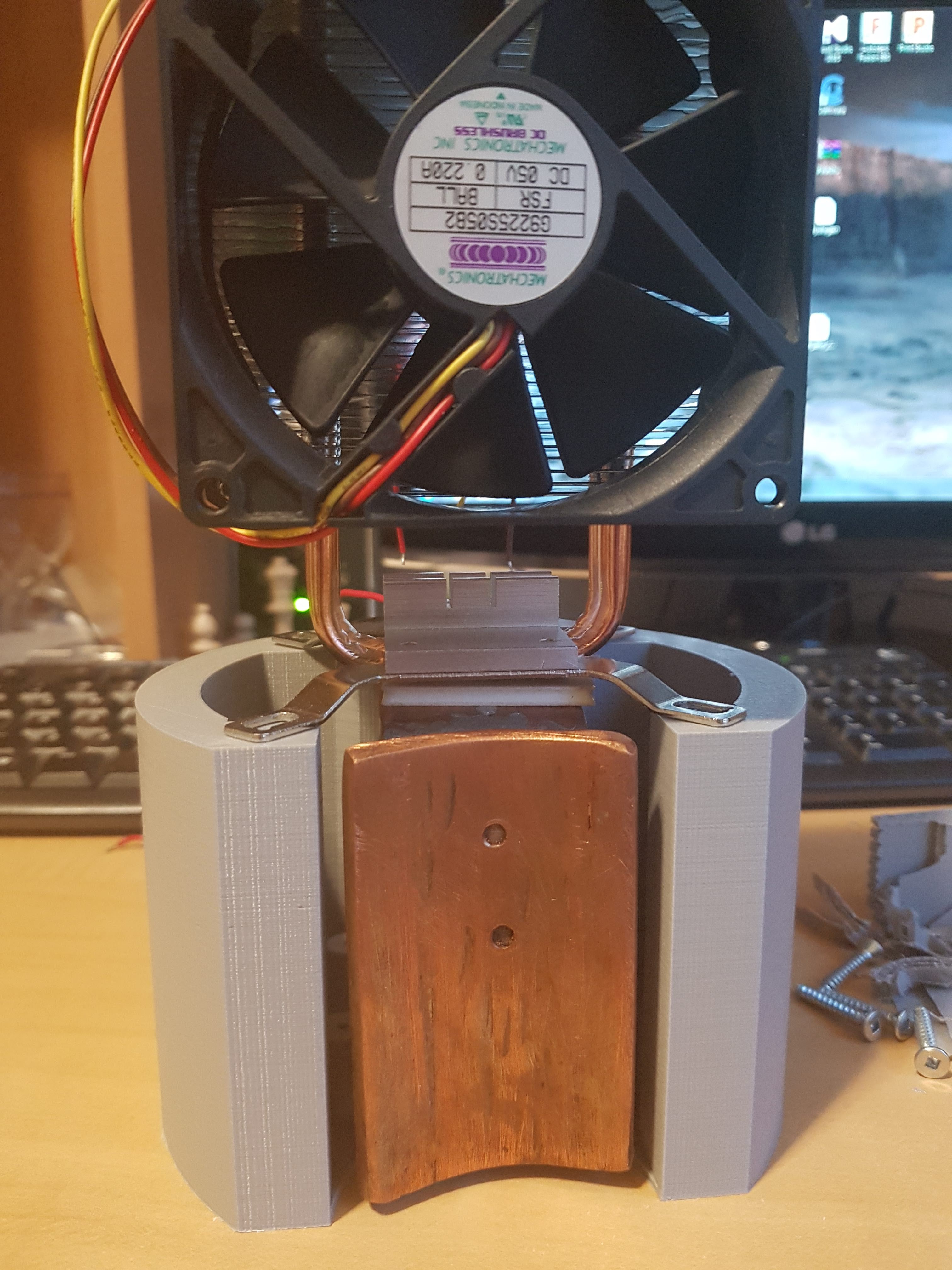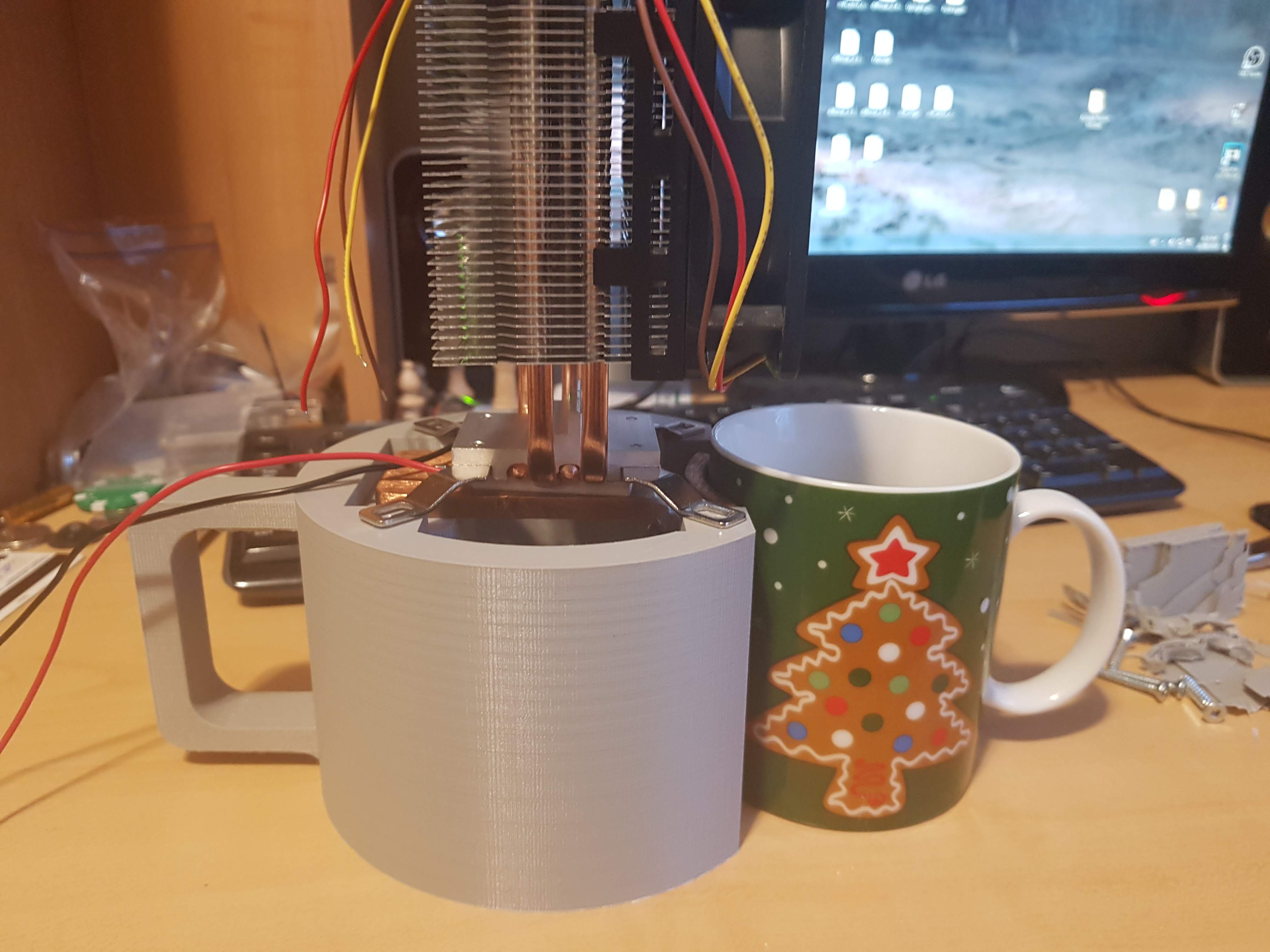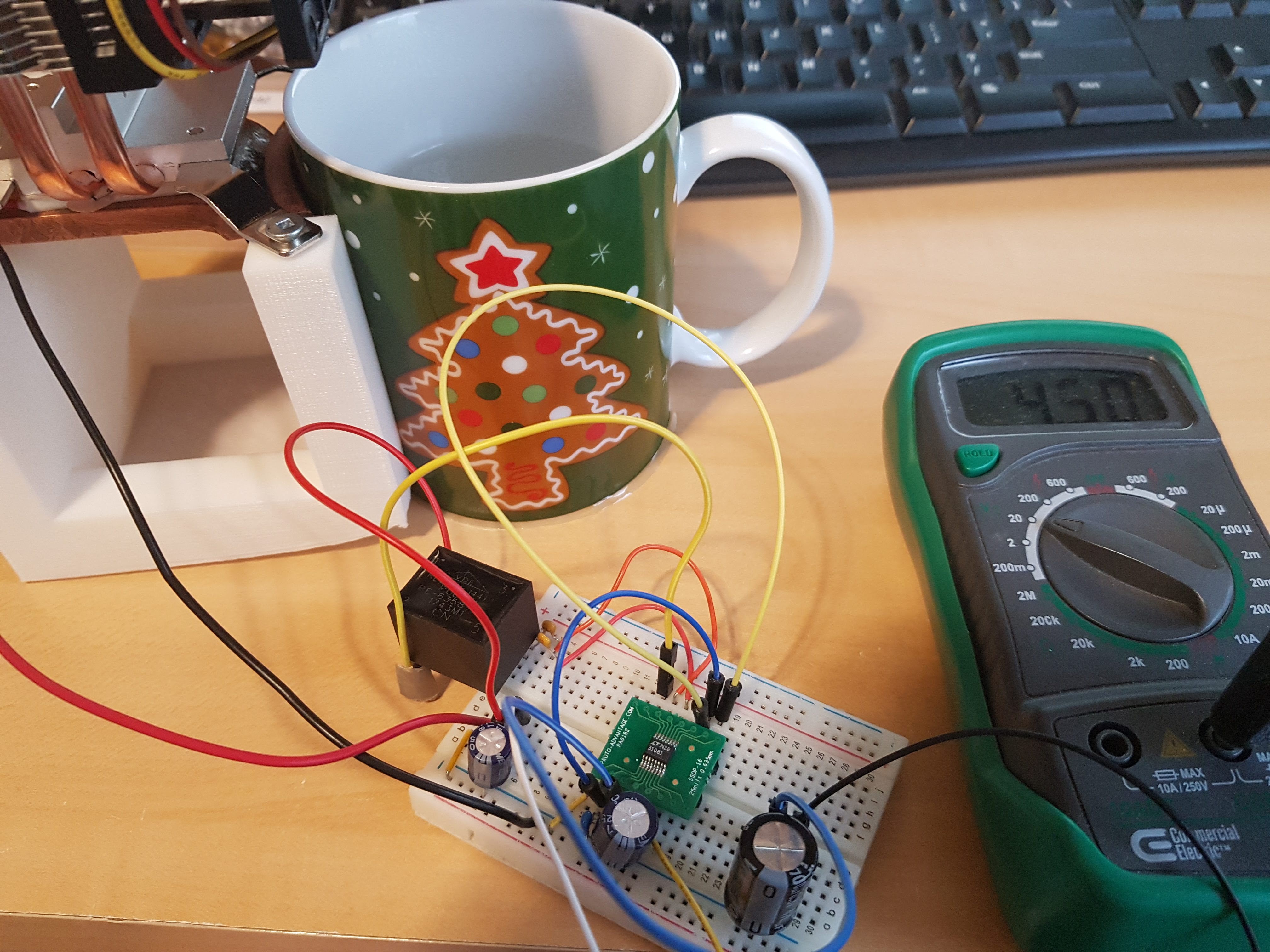-
Closing Thoughts
07/16/2018 at 05:18 • 0 commentsWell, I definitely overestimated what one of these small TEG units could do, and my goals were a bit too ambitious. At least I was able to achieve a bit of what I set out to do. While it doesn't really generate much meaningful energy, at least it functions fairly well as a temperature alarm.
This project had no shortage of hurdles and design changes, but with those a lot of learning happened. It was a fun exercise in designing and troubleshooting. This is one of the few projects I've done with only analog circuitry, and it's made me appreciate projects where I don't need to worry about how much energy it uses.
Things to improve:
1. Copper conductor was too thick. Too much energy/time wasted heating all of the copper. The copper remaining warm for a long time after use did not benefit me as it was not usable to generate more energy.
2. Circuitry was not as optimized as it could have been, particularly the thermistor that was used to remove the offset caused by ambient temperature. I did not have time/desire to dial in the resistor values to maximize stability.
3. TEGs require some serious temperature differential to generate a meaningful amount of energy. I will have to try to find a copper mug to see how well that does. There never was much hope trying to harvest heat from the side of an insulator.
Even though the device doesn't really save much energy at all, at least it is something I can use and show off to guests.
![]()
Cheers!
-
Putting it all together
07/16/2018 at 04:08 • 0 commentsAs my design continued to change, I quickly ran out of space on the circuit board and had to improvise to fit it all inside the housing.
![]()
![]()
![]()
![]()
![]()
![]()
![]()
![]()
One of these days I will make a project that doesn't involve jamming a mess of wires into an enclosure. But not today.
-
The Results are in...
07/15/2018 at 07:30 • 0 commentsI've determined the amount of energy this generates compared to what it uses. I may have the honour of having the project this year with the most inefficient method harvesting of energy!
I measured the amount of current being supplied to the battery to determine the effective mAh generated or saved. I did this measurement for the device with and without the cooling fan. The circuitry drew about 6mA on average, while the fan drew nearly 60mA on average. As you can see below, the amount of energy harvested is no where near what is used.
There are a lot of things that are interesting to note here. The current supplied when the energy harvesting chip was starting up was very constant around 3.0uA to 3.3uA. Then once everything received enough power (I assume) it rapidly began increasing (rapid in terms of uA anyways).
With the fan, the current generated rose very fast and leveled off around 40uA. Just after the cup was removed however, the energy generated fell off quickly. Once again it plateaued around 3uA before going to 0. These results show that even though the copper stays hot a while after use, it is not hot enough to charge the battery. A big part of this is that without the fan, the temperature differential of the TEG falls as the heat continues to flow.
Without the fan, the energy generated peaked much lower and gradually fell, far before the cup was removed. The reason for this as mentioned above was the fact that the heat sink could not exchange the heat fast enough without the fan, causing the temperature differential to fall.
The Math
The energy generated with the fan running was certainly better, but it came at a cost. The fan itself took over 1000 times as much energy to run that was generated at the peak. This means that the battery life would not be extended a meaningful amount when the fan was running.
I determined the equivalent mAh generated by calculating the average mA generated across the measurements, and multiplying that by the length of time. This may not be the exact or best way to determine the actual mAh added back to the battery, but was the best I could do.
With Fan
Battery capacity = 3000mAh
mAh drawn over 600s = 10mAh
Amount of device uses without generated energy = 300
--
Average current supplied over 600s = 15.9uA
mAh generated over 600s = 0.002262mAh
Amount of device uses with generated energy = 300.068
--
This has barely extended the life of the battery, extending it by about 0.023% (yes the decimal is in the right place).
Without Fan
Battery capacity = 3000mAh
mAh drawn over 975s = 1.625mAh
Amount of device uses without generated energy = 1846.15
--
Average current supplied over 975s = 9.25uA
mAh generated over 975s = 0.002505mAh
Amount of device uses with generated energy = 1849.00
--
This has extended the life of the battery, extending it almost 3 full uses! The battery life is extended by about 0.15%. Without the fan, the device is able to generate enough electricity for one full use after 577 uses. That is a LOT of tea/coffee.
The results are very poor, but they are results!
-
Designing the Circuit
07/14/2018 at 07:13 • 3 commentsDesigning the circuit was an evolving process partially based on trial and error.
Energy Harvester - LTC3108-1
In the end I decided to stick with the LTC3108-1. It is able to boost the low TEG voltage up to around 5V (though any attempt to put a load on dramatically drops the voltage.
Charger - Module Based on CN3083
I purchased a battery charging module that is able to control incoming power to charge the battery without overdriving and dropping the voltage too much. There were two LEDs on the module that indicated charging and charged states that I removed.
The output of the module powers all of the temperature monitoring circuitry, LED, and fan. I have a disconnect before all of that so that everything can be shut off while the harvester is still generating electricity.
Voltage Regulator - LM317
The voltage regulator was a late addition to the party. I initially had everything running off the battery voltage, but realized that as the battery gradually dropped, the calculations and calibrations would cause inaccuracy. In order to keep everything operating the same regardless of battery life was to keep the voltage exactly the same. I used a voltage of 2.27V to keep enough difference in Vin and Vout to keep the regulator constant. I calculated for around 2.2V, but got an output of 2.27V with common resistor values, so I made my calculations based off that number.
Thermopile Temperature Sensor - ZTP-135SR
The left side of the circuit is required to linearize the thermistor that is measuring the ambient energy. This doesn't do a great job, as the output isn't very linear with ambient temperature change, but it is good enough for this project (especially given the short timeline before the deadline).
Amplifier - MCP6002
The thermopile itself does not require any input voltage, but gives off a small voltage based on the amount of infrared radiation. Since it is so small I've used an amplifier to amplify the signal by a factor of 100.
Comparator - MCP6542
I used a non-inverting comparator to trigger the output to go high when the desired value was reached. With the new supply voltage of 2.27V, the output of the thermopile amplifier was about 0.428V at 60 degrees C. I could have used the inverting comparator to have the output go high once the temperature was reached, but for simplicity just had the device sink the current rather than source it.
-
Effects on Methods of Cooling
07/02/2018 at 18:13 • 0 commentsOne of the interesting questions that arises from this idea is how much faster we can cool down a cup of coffee or tea. I took some data by measuring the time at which each degree of temperature was reached. Apologies for the terrible charts, the temperature probe I have only measures to the nearest degree Celsius. To get the most accurate measurements I recorded the time measured as soon as the degree changed.
Time to reach 60°C:
Natural Cooling - 13 minutes 39 seconds
Cooling Next to Copper - 12 minutes 16 seconds
Cooling Next to Copper with Fan (3.7V) - 8 minutes 6 seconds
Natural Cooling
This was the control of the small experiment. Almost 14 minutes is a long time to have to wait for the perfect temperature to come along.
Cooling Next to Copper
In addition to harvesting some energy, the copper does a noticeable job of cooling the drink by transferring some of the heat away from the cup. The peak voltage generated was 304mV. I recently added a thermal pad to the conducting surface to better conform to the cup. It improved the peak voltage generated by about 30-40mV.
![]()
Cooling Next to Copper with Fan
Using the fan constantly at 3.7V (the voltage of a LI-ion battery) had significant results by reducing the cooling time to 60°C by over 5 minutes and 30 seconds. The TEG was able to generate 349mV at the peak as the fan also pulled heat away from the heat sink, therefore increasing the temperature differential.
The constant current draw of the fan was measured as 56.6mA. Over the 8 minutes and 6 seconds of cooling, less that 8mAh of energy was used by the fan. Once the charging circuit is finalized, I will determine how much energy is produced over the full generation stage of the TEG.
The ultimate hope would be that this device could produce enough energy over time to make up the energy used by the fan. At the very least getting some energy back to extend the life of the battery will be considered a partial success.
-
Power Generation Issues
07/01/2018 at 20:32 • 0 commentsI've hit a major snag in that my TEG is not generating enough constant power to adequately run the new thermopile amplifier circuit (typical draw in the datasheet is 100uA). Running the circuit off of the LVDO regulator dropped the LVDO supply voltage to roughly 1V where it should normally be 2.2V. The sensor still output different temperatures at different voltages, but I am not confident with the results as the op-amp rated minimum supply voltage is 1.8V.
More Design Changes
The project is heading off the rails again, so I will need to change things up. My plan is now to run the project off of a Li-ion battery, and rely on making up for the power used in the generation stage after the cup has been cooled down.
As the copper remains warm for a long time after being beside a cup, there is a lot of time here for trickle charging. I want to go with a battery as opposed to a capacitor so I can work with a more constant voltage level. Maybe if I get this working with a battery I will try a supercapacitor, but for now I don't want to complicate things so I can get the damn thing working.
I have a couple options I will be exploring for battery charging.
1. LTC3108-1 + Li-ion charging module
The LTC3108-1 is the current energy harvesting chip I am using, I'll use the output of that to charge the battery. The charging module I've ordered is not specifically designed for low power trickle charging, so I am skeptical of how it will work. There are a couple LEDs on the module that show the status of charging, so at the very least I will be removing those to make sure there is no chance of wasting energy on those.
2. bq25504
A helpful user named Vinalon suggested this chip in this Hackaday article. This chip does both the low power energy harvesting as well as the battery management. I want to see how this compares to my current circuit.
-
Temperature Sensing
07/01/2018 at 02:26 • 0 commentsIn order to alert the user when their drink is cooled down, I need to roughly know the temperature. The major constraint here is running off low power, so I need an analog only solution as I won't be using a microcontroller. If I could avoid it I want to find a solution where I don't have to stick a temperature probe into my drink.
Thermistor Design
When searching for a device to monitor temperature I was first drawn to a thermistor. The analog output and low power draw were desirable. The idea was to monitor the ambient temperature above the cup. I knew it wouldn't be very accurate, but that the temperature above the drink should roughly correlate with the temperature of the liquid. I was very wrong.
![]()
MCP9700 Thermistor I 3D printed a housing to hold the thermistor above the cup. Space for two magnets was made on the housing so this can be loosely attached to the heat sink base.
It was a pretty big failure all around. The first downside is that it doesn't begin at the proper temperature as the air below it slowly begins to warm up. This would make it more difficult to know when the proper temperature is reached, as it rises above the trigger point, where the goal of this is to trigger when it falls below that temperature.
The second downside is the effect of airflow on the sensor. Changing air currents would dramatically change the temperature sensed. This means that a person blowing on their drink could trick my system into thinking it had cooled down all the way.
The third downside, and the real killer of this idea is that it didn't correspond at all to the liquid temperature. The ambient temperature would continue to rise while the temperature of the drink began to fall. Up to a certain point the ambient temperature would begin to fall, but in an undesirable point of time.
Themopile Design
I did some more research and realized an option was out there to use a themopile IR temperature sensor. I found a part specifically for IR temperature measurement. The ZTP-135SR sensor has a built-in thermopile for IR sensing as well as a thermistor to monitor the ambient temperature. The output of the thermopile is dependent on the ambient temperature, so it is necessary to know the ambient temperature in order to know the temperature of the surface being measured. The datasheet for the above sensor didn't explain much, but I found a great resource from Hamamatsu on thermal detectors.
This explains a bit of the theory of operation, as well as shows some application circuits which I based my design on. The output of a thermopile is determined as follows.
Where To is the object temperature, Ta is the ambient temperature, S is the sensitivity coefficient, and B is a coefficient of about 4. S and B are determined by measurement and are based on the individual sensor. As my use for it doesn't involve any calcluations, all I need to know is the voltage that corresponds to 60 degrees C (which can be done experimentally).
I built the below circuit as recommended by the Hamamatsu document above.
![]()
This thermopile only produces only about -5mV to 10.5mV, so an amplifier is need to get this into a more measureable value. The resistor network on the left serves to linearize the thermistor output. This can feed into the negative feedback of the amplifier to minimize the effect of changes in ambient temperature (which are a big issue for this design). This circuit aims to use the 2.2V low voltage dropout regulator of the harvesting chip. Through the equations derived in the document, my values were as follows. I used approximations in my test circuit, but will try to get closer for the final design.
Ra = 164kΩ
Rb = 1.46kΩ
Rc = 730Ω
Rd = 45.6kΩ
I designed the thermopile housing similar to the thermistor one before.
![]()
I tested the circuit with a regulated 2.2V supply in case the harvesting circuit could not supply adequate power. I did two separate tests. One set of measurements with the cup 75% filled, and one set with the cup 90% filled. I wanted to know the proximity to the sensor had.
Measurements were taken at each degree interval. A proper datalogger would show the actual data fluctuations, but this gives a good idea of the trend and confirms it is reasonably linear.
There is an obvious offset introduced here, but it isn't too bad, and can hopefully be fixed by getting closer resistance values to the values calculated. Measurements in the range between 80°C and 70°C do not show the whole story, as between this range there was great fluctuation in voltage, sometimes as large as 30-50mV. This is very likely caused by varying air currents caused by the evaporating water. Blowing on the cup would have a similar effect.
Near the 65°C to 55°C rage the output was a lot more stable, typically only fluctuating as much as 5mVto 10mV. It was often stable within 2mV to 3mV, yielding pretty stable results. This was a successful test and is accurate enough for the purposes of my design.
At 60°C I had outputs of 313mV and 328mV. Some tightening up of the resistor values should help with the offset, but my trigger voltage will likely be around 320mV. This voltage level will be what determines when the LED begins to flash.
-
Final Housing Design
06/23/2018 at 06:23 • 0 commentsI designed a new housing for it to be more aesthetically pleasing and with small improvements. I moved the copper screw hole closer to the front so the thermoelectric generator sits it a more optimal place between the copper and the heat sink. Secondly I raised the assembly a bit higher so the copper would not be touching the surface of the table.
This was modeled in Autodesk Fusion 360, and printed with with a Craftbot + with PLA. The print time was about 20 hours. There are standoffs built for a 40mm x 60mm prototype circuit board.
![]()
![]()
![]()
![]()
-
Current Supply
05/29/2018 at 05:08 • 0 comments
When trying to drive an LED at the output, my output voltage dropped dramatically because I was overloading supplying circuit. It had taken me a while to figure out why my supercapacitor was not charging (or was charging incredibly slowly). Eventually I realized that was happening for the same reason my output was dropping. I didn't have a current limiting resistor for my storage cap, so it was trying to draw a lot of current to charge up very quickly, this itself was overloading the supply.This isn't too surprising as this type of circuit is not meant to power a lot of stuff directly, but to trickle charge a battery or capacitor.
I need to charge the storage capacitor as quickly as possible, while being realistic about the maximum current draw available to me. My next test was to assume 5mA constant draw without affecting the output voltage (way too optimistic).
Since I want this to charge as fast as possible, I want the lowest resistance value I can get, so I've selected the lowest output voltage available to me.
Since fully charged is about 5 periods of the time constant, this would take over 40 minutes to fully charge. This time gets even worse if my device can't source 5mA without overloading (which is not likely) This isn't ideal for my application as I want to be flashing an LED after several minutes at the very latest.
Because of this long charge time, I won't be using a supercapacitor for the main function of this device. I will consider it for other uses possibly including running the fan, or charging a phone. Once the device is not in use, it still holds a temperature differential for quite a while, meaning there is more energy to be harvested.
-
Test circuit and using the power
05/27/2018 at 06:40 • 0 commentsI'm generating some power so it's time to try to use it. I'm using the LTC3108-1 step up converter which appears to be a fairly recognizable choice for energy harvesting applications. Normal buck-boost converters won't work for this application as the voltage produced is too low. This chip is able to work with voltages between 20mV to 500mV.
![]()
This is the circuit I'm going with, except I am only using Vout. There are some different sources available and a status pin that I won't be needing. An output voltage of 2.5V, 3V, 3.7V, or 4.5V can be selected based on what VS1 and VS2 is tied to. You can refer to the datasheet for more information and an idea of how it works.
![]()
I tried taking the output and applying it to the heat sink fan and to some small DC motors, but didn't have much luck. The motor would ever so slightly turn before the output voltage began to rapidly drop to 0V. The supercapacitor on Vstore didn't seem to help the issue as it would not charge to 4.5V (which I will discuss later).
I tried thinking smaller and put an LED and 200ohms of resistance at the output. Connecting it would have the LED start bright and eventually stabilize at a dim light level. I was only getting 1.5V at the output. With 8.3mA through the LED, it appears I was able to generate 12.5mW maximum from the TEG. I should be able to improve this with thermal paste between the TEG and the heat source and sink, and possibly some insulation on the unused surfaces of the copper.
It is pretty clear though that with such limited power it won't be ideal or possible to run a microcontroller and fan constantly. I've got some ideas on efficient uses of power that can still make this a useful device.
Coffee/Tea Cooling Buddy
Monitor the temperature of your drink and know when it reaches the perfect temperature. Even generates a tiny bit of electricity too!
 Scott Clandinin
Scott Clandinin